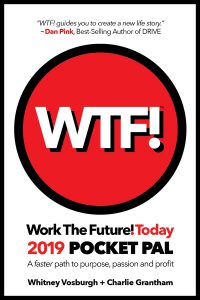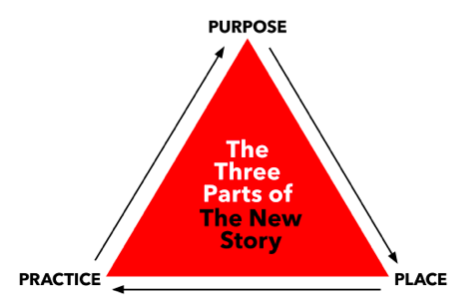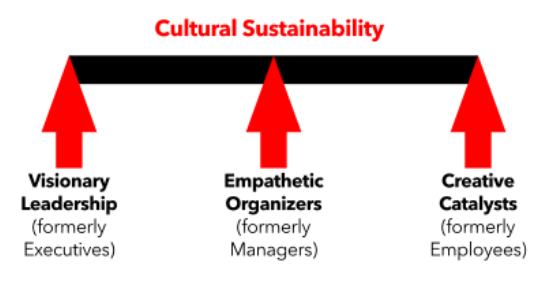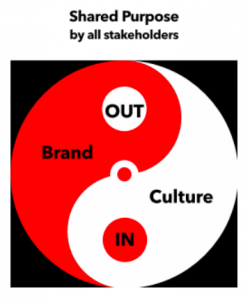Editor’s Note: The following is an excerpt from “WORK THE FUTURE! TODAY 2019 POCKET PAL: A faster path to purpose, passion and profit,” available on Amazon.
 For the past 20 years, we’ve worked with a wide range of companies and organizations all over the world, including a number of Fortune 20 companies. We’ve noticed a growing sense of dissatisfaction, and the desire of both leaders and employees at all levels to find greater meaning and impact in their work. As we begin 2019, this widespread hunger for a new sense of fulfillment in our work and the need for transformation to meet the challenges that constant change bring is more prevalent than ever. With this in mind, we offer a step-by-step path to filling this void with a new sense of shared purpose and value.
For the past 20 years, we’ve worked with a wide range of companies and organizations all over the world, including a number of Fortune 20 companies. We’ve noticed a growing sense of dissatisfaction, and the desire of both leaders and employees at all levels to find greater meaning and impact in their work. As we begin 2019, this widespread hunger for a new sense of fulfillment in our work and the need for transformation to meet the challenges that constant change bring is more prevalent than ever. With this in mind, we offer a step-by-step path to filling this void with a new sense of shared purpose and value.
The purpose of transformation
Old into new: In 2019, we need to transition more than ever from the Old Story of Profit First to the New Story of Purpose, which is made possible by a three-part path, which we call Working The Future! Today:
- Purpose: Why?—your destiny.
2. Place: Who?—your destination.
3. Practice: How?—your journey.

To pull all this together with a clear view of the path forward, we explore foundational thoughts on perennially popular corporate topics: collaboration, innovation, and transformation—all of which are about creating a better today and tomorrow.
The Old Story of Profit First is dying, and there is nothing to replace it. What we desperately need and yearn for is a New Story of Purpose First. The old triple bottom line of profit, people, planet—in that order—has taken many of us far, but no longer. We need a new triple bottom line of planet, people, profit. Why? With no planet and no people, there can be no profit. Companies must become prophets of the new, so they can continue to earn new profits. In order for companies to accumulate wealth, they must not only share the wealth but also ultimately recognize the role of all parties in the co-creation of that wealth—commonwealth.
Transformation nation: Sadly, so many people have neither meaningful work nor life, which is made dramatically evident by the rapid rise in our suicide rates, opioid addictions, debilitating stress levels, and lack of civic engagement across almost all demographics—the United States of Alienation.
Collaboration into sharing: People do not truly collaborate unless they know their best interests have been fully embraced. That is called shared purpose. Innovation does not happen in a vacuum—it is part of an interconnected chain of simultaneous events, factors, and influences such as shared purpose, vision, and leadership, as well as inspiration, imagination, and invention; all of that leads to shared value creation.
What combines shared purpose and co-creation of a future desired state is community, and from both the corporate and stakeholder points of view the ultimate fruit of these unions is called commonwealth, wealth for all, not just for the one percent. Within the corporation, that commonwealth is called culture—all that you do and don’t do relative to others in the minds, hearts, and wallets of your brand community of stakeholders and the places you do business.
The purpose-profit connection: In the New Story, which is the future of work, there is a direct connection between purpose and profit. All healthy businesses are founded with a core purpose and values, as well as a vision, mission, and value proposition. Purpose has to come before profit, not only at the inception of a business, but all through the business lifecycle. Increasingly, the more stakeholders have an ever-renewing brand, a new sense of positive purpose and value, the more profitable and sustainable a business will be. Customer experience and content are made from these threads.
Transformation is not a standalone concept. It is like a valued brand: an active, shared, positive, and aligned purposeful culture, which is built on a foundation of strong, emotional, transformative experiences such as a sustaining story of origin—why we exist and whom we serve—to serve as a collective and sustaining north star. A healthy, vibrant sustainable culture has three legs:

Each leg is supported by its brand community of stakeholders. The stronger the community, the stronger and smoother support for the three legs of the culture. Incremental innovation is possible without a purposeful culture. However, continual transformation is only possible in a purposeful culture, and without continual transformation, businesses and organizations will not be sustainable. They will be tomorrow’s corporate road kill, squashed by relentless competition, change, and transformation.
The power of transformation
Work The Future, Today: Collaboration, innovation, transformation: There are two basic processes that bring the future to you and your organization: innovation and transformation. Too much has been written about innovation and too precious little on transformation. And neither is truly possible without collaboration, which is the social glue holding and bonding them together.
Collaboration, at a conceptual level, involves:
- Awareness: We become part of a working entity with a shared purpose.
- Motivation: We drive to gain consensus in problem-solving or development.
- Self-synchronization: We decide as individuals when things need to happen.
- Participation: We participate in collaboration and we expect others to participate.
- Mediation: We negotiate, collaborate, and find a middle point.
- Reciprocity: We share and we expect sharing in return through reciprocity.
- Reflection: We think and consider alternatives.
- Engagement: We proactively engage rather than wait and see.
Innovation is the harnessing of creative thought and action to a useful end for a short-term goal, which is meant to—at best—keep you where you are today, instead of slipping back.
Transformation is:
- Future value creation for a shared long-term goal.
- A shared act of imagination translated into a treasured future.
- The art of scientifically bringing creativity continuously to life.
- Applied creativity that makes a long-term difference.
- Irreversible, substantive, creates new identity, and contains a shift in purpose.
- A shared activity where people come together to co-create the future today and create something of lasting and sustaining value.
 Creating your brand new story: It might be said that true and sustainable transformation is about creating an ever-renewing story encapsulated in a living, breathing brand and culture that is kept together by shared purpose and value. The three ingredients of a sustainable culture—sustained by shared purpose—in the new world of work are:
Creating your brand new story: It might be said that true and sustainable transformation is about creating an ever-renewing story encapsulated in a living, breathing brand and culture that is kept together by shared purpose and value. The three ingredients of a sustainable culture—sustained by shared purpose—in the new world of work are:
- Brand Purpose (WHY: promise, passion, and perception)
2. Brand Participation (WHO + HOW: partnership, participation, and process)
3. Brand Performance (WHAT + WHEN + WHERE: planet, people, and profits)
What’s your New Story? Purpose, leadership, and place let you pull the future toward you. You surround it, you dance with it, and you make it real and share it with others.
The outlines of the New Story narrative are emerging from the fog of the past. It’s more about harmony instead of control; it’s more feminine than masculine; it’s more about stewardship than exploitation; it’s more about co-creation than about what’s already built. And it’s more about living in the present with an eye to the future than not being present and looking toward the past.
We conclude with a playbook to get you started on your pathway to purpose, possibility, and plenty. The path to sustainable profits and overall sustainability is through shared, aligned positive purpose.
The path of transformation
“The cave you fear to enter holds the treasure that you seek.” — Joseph Campbell
Finding your true north: The way to make your way along the path of emotional transformation toward purpose parallels the classic story of the hero’s journey. It is a path of what Carl Jung called individualization or becoming oneself. Or, in an organizational setting, finding your purpose—your true north. The process by which this occurs is called differentiation and has as a goal of the development of the individual or organizational personality, the discovery, and acceptance of one’s true purpose. The path is often summarized as having seven distinct, but overlapping, stages.
The brand new path to purpose: Now, we are at a point in our journey where we need to look at just how we’re supposed to be able to make this transition to purposeful and sustainable transformation. Use this seven-step path to guide you and your organization through this transition.
Below you’ll find the steps in the order you’ll take them. For each step, you’ll see the name of the state associated with that step, the quality you should be experiencing during that particular stage of transition, and the activity you’ll associate with that step.
7 Steps: The purpose path
Step 1. Initiation: Recognizing the Real World
- Socialization: Looking from outside to inside.
- Brand focus: Your focus is on your brand.
- Brand development (activity): Awareness that something is missing and time is passing. You move to get something you need. You begin seeking answers to nagging questions, such as “What is our core purpose?”
Step 2. Involvement: Call to Adventure
- Brand action: Struggle: Looking from inside to outside.
- Brand focus: Your focus is your brand in the marketplace.
- Brand development (activity): Looking at parts of ourselves we don’t want to look at. Introspection: “Is it us or has the world changed without us?”
Step 3. Inquiry: Meeting the Mentor
- Brand action: Service: Moving from inside to outside.
- Brand focus: Your focus is on your brand community.
- Brand development (activity): Sharing what we know in order to build future capability with our stakeholders and the communities where we do business. Sharing provides a bridge from what was to the New Story.
Step 4. Improvement: Crossing the Threshold
- Brand action: Showtime: Going from old playbook to new.
- Brand focus: Your focus is on brand activation.
- Brand development (activity): Creativity is expressed through innovative culture. You experience the “flow” state and begin to act in brand new ways, building off the old into long-term sustainability.
Step 5. Inspiration: Road of Trials
- Brand action: Sensing: Opening up to co-creation.
- Brand focus: Your focus is on collaboration with your brand community.
- Brand development (activity): Actively co-creating brand value and perception. Firmly committed to a pathway of purposeful change.
Step 6. Innovation: Seizing the Prize
- Brand action: Stewardship: Walking your talk.
- Brand focus: Your focus is on brand leadership.
- Brand development (activity): Realizing and acting upon new marketplace demands such as authenticity, transparency, responsibility, and engagement.
Step 7. Iteration: Return with the Treasure
- Brand action: Simplification: Knowing shift happens.
- Brand focus: Your focus is on your brand future.
- Brand development (activity): Oh, shift! Developing a firm grasp of the obvious: Purpose = profits. Change, complexity, and competition are relentless and ruthless.
Call to Action for a Brand New World
Humans change at the speed of snails, but everything around us changes quickly and all the time, with ever greater velocity, impact, and complexity. We all need a flexible new framework. We call this contextual re-imagination. If you want to grow or keep growing your brand, you need to keep it new and stay focused on your shared purpose and value, while embracing change and possibility, and driven by continuous renewal through collaboration, innovation, and transformation.





